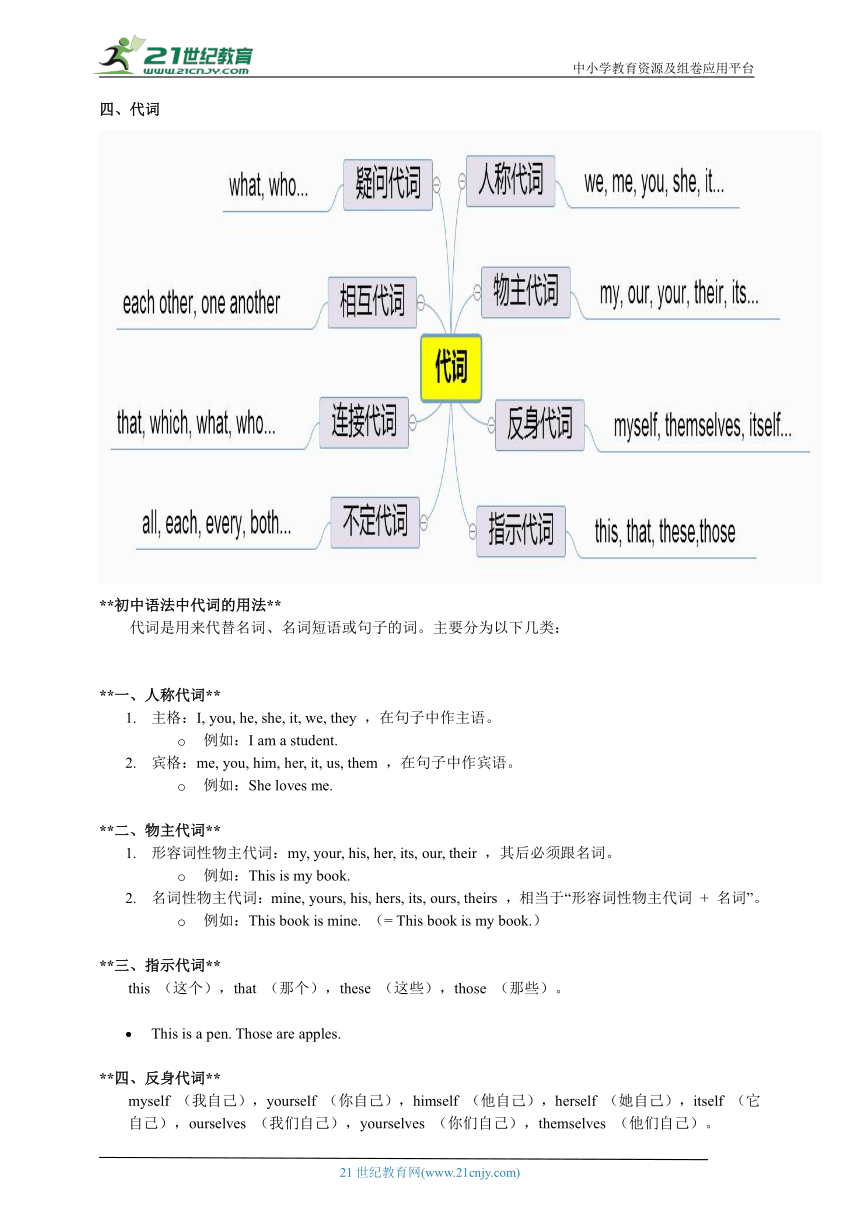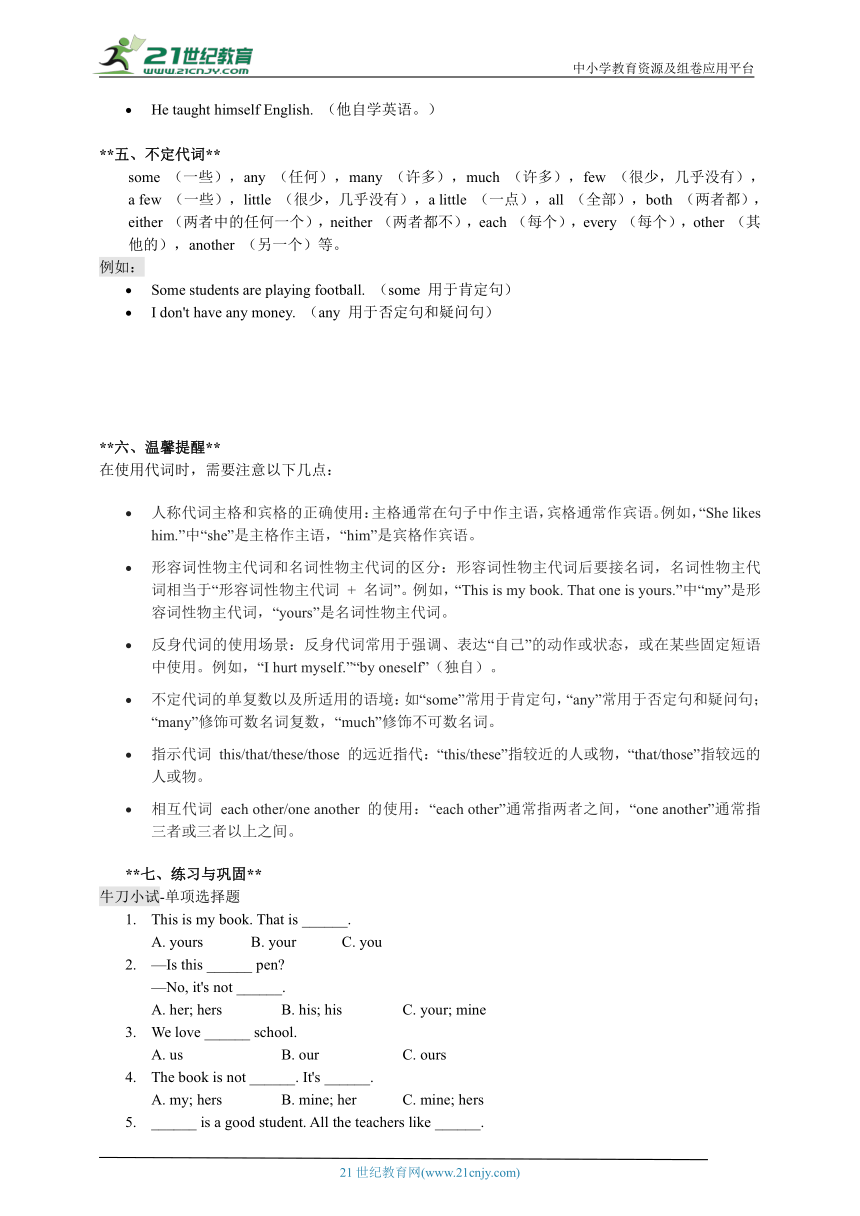四、代词-精讲精练【思维导图突破初中英语语法】(含答案)
文档属性
| 名称 | 四、代词-精讲精练【思维导图突破初中英语语法】(含答案) |

|
|
| 格式 | doc | ||
| 文件大小 | 219.4KB | ||
| 资源类型 | 试卷 | ||
| 版本资源 | 通用版 | ||
| 科目 | 英语 | ||
| 更新时间 | 2024-07-23 10:01:17 | ||
图片预览


文档简介
中小学教育资源及组卷应用平台
四、代词
**初中语法中代词的用法**
代词是用来代替名词、名词短语或句子的词。主要分为以下几类:
**一、人称代词**
主格:I, you, he, she, it, we, they ,在句子中作主语。
例如:I am a student.
宾格:me, you, him, her, it, us, them ,在句子中作宾语。
例如:She loves me.
**二、物主代词**
形容词性物主代词:my, your, his, her, its, our, their ,其后必须跟名词。
例如:This is my book.
名词性物主代词:mine, yours, his, hers, its, ours, theirs ,相当于“形容词性物主代词 + 名词”。
例如:This book is mine. (= This book is my book.)
**三、指示代词**
this (这个),that (那个),these (这些),those (那些)。
This is a pen. Those are apples.
**四、反身代词**
myself (我自己),yourself (你自己),himself (他自己),herself (她自己),itself (它自己),ourselves (我们自己),yourselves (你们自己),themselves (他们自己)。
He taught himself English. (他自学英语。)
**五、不定代词**
some (一些),any (任何),many (许多),much (许多),few (很少,几乎没有),a few (一些),little (很少,几乎没有),a little (一点),all (全部),both (两者都),either (两者中的任何一个),neither (两者都不),each (每个),every (每个),other (其他的),another (另一个)等。
例如:
Some students are playing football. (some 用于肯定句)
I don't have any money. (any 用于否定句和疑问句)
**六、温馨提醒**
在使用代词时,需要注意以下几点:
人称代词主格和宾格的正确使用:主格通常在句子中作主语,宾格通常作宾语。例如,“She likes him.”中“she”是主格作主语,“him”是宾格作宾语。
形容词性物主代词和名词性物主代词的区分:形容词性物主代词后要接名词,名词性物主代词相当于“形容词性物主代词 + 名词”。例如,“This is my book. That one is yours.”中“my”是形容词性物主代词,“yours”是名词性物主代词。
反身代词的使用场景:反身代词常用于强调、表达“自己”的动作或状态,或在某些固定短语中使用。例如,“I hurt myself.”“by oneself”(独自)。
不定代词的单复数以及所适用的语境:如“some”常用于肯定句,“any”常用于否定句和疑问句;“many”修饰可数名词复数,“much”修饰不可数名词。
指示代词 this/that/these/those 的远近指代:“this/these”指较近的人或物,“that/those”指较远的人或物。
相互代词 each other/one another 的使用:“each other”通常指两者之间,“one another”通常指三者或三者以上之间。
**七、练习与巩固**
牛刀小试-单项选择题
This is my book. That is ______.
A. yours B. your C. you
—Is this ______ pen
—No, it's not ______.
A. her; hers B. his; his C. your; mine
We love ______ school.
A. us B. our C. ours
The book is not ______. It's ______.
A. my; hers B. mine; her C. mine; hers
______ is a good student. All the teachers like ______.
A. She; her B. Her; she C. Hers; her
There are some apples. You can take ______.
A. one B. ones C. it
______ of the girls is in the classroom.
A. Both B. All C. Neither
I have two brothers. One is a doctor, and ______ is a teacher.
A. another B. the other C. other
There is ______ water in the bottle.
A. a little B. little C. few
—Do you have ______ to say
—No, I have nothing to say.
A. something B. anything C. everything
答案:
A (“yours”是名词性物主代词,相当于“your book”)
C (第一个空用形容词性物主代词“your”,第二个空用名词性物主代词“mine”)
B (“our”是形容词性物主代词,修饰“school”)
C (两个空都要用名词性物主代词)
A (第一个空作主语用主格“She”,第二个空作宾语用宾格“her”)
A (“one”指代一个苹果)
C (“neither”表示“两者都不”,谓语动词用单数)
B (“one...the other...”表示“一个......另一个......”)
A (“water”不可数,“a little”表示“一点”,“little”表示“几乎没有”,“few”修饰可数名词)
B (一般疑问句中用“anything”)
巩固加强-结合语句意思,用所给词的正确形式填空
This dress is not hers. ______ (She) is on the bed.
The books are not mine. They are ______ (you).
We teach ______ (we) English.
This is not my coat. ______ (My) is red.
______ (These) rulers are his.
______ (Some) of the boys are playing football.
______ (Both) of my parents are teachers.
Here are two apples. You can take ______ (either) of them.
I have many friends. ______ (Many) of them are from China.
There is ______ (few) water in the bottle.
答案
Hers
yours
ourselves
Mine
These
Some
Both
either
Many
little
解析
“Hers”是名词性物主代词,相当于“her dress”,在句中作主语。
“yours”是名词性物主代词,相当于“your books”。
“ourselves”是反身代词,“teach oneself”表示“自学”。
“Mine”是名词性物主代词,相当于“my coat”,作主语。
“These”是指示代词,修饰复数名词“rulers”。
“Some”表示“一些”,可用于肯定句。
“Both”表示“两者都”,后接 of 短语,谓语动词用复数。
“either”表示“两者中的任何一个”,根据句意“这有两个苹果,你可以拿其中任何一个”。
“Many”表示“许多”,后接 of 短语,表示“......中的许多”。
“few”修饰可数名词,“water”是不可数名词,应用“little”表示“几乎没有”。
21世纪教育网 www.21cnjy.com 精品试卷·第 2 页 (共 2 页)
HYPERLINK "http://21世纪教育网(www.21cnjy.com)
" 21世纪教育网(www.21cnjy.com)
四、代词
**初中语法中代词的用法**
代词是用来代替名词、名词短语或句子的词。主要分为以下几类:
**一、人称代词**
主格:I, you, he, she, it, we, they ,在句子中作主语。
例如:I am a student.
宾格:me, you, him, her, it, us, them ,在句子中作宾语。
例如:She loves me.
**二、物主代词**
形容词性物主代词:my, your, his, her, its, our, their ,其后必须跟名词。
例如:This is my book.
名词性物主代词:mine, yours, his, hers, its, ours, theirs ,相当于“形容词性物主代词 + 名词”。
例如:This book is mine. (= This book is my book.)
**三、指示代词**
this (这个),that (那个),these (这些),those (那些)。
This is a pen. Those are apples.
**四、反身代词**
myself (我自己),yourself (你自己),himself (他自己),herself (她自己),itself (它自己),ourselves (我们自己),yourselves (你们自己),themselves (他们自己)。
He taught himself English. (他自学英语。)
**五、不定代词**
some (一些),any (任何),many (许多),much (许多),few (很少,几乎没有),a few (一些),little (很少,几乎没有),a little (一点),all (全部),both (两者都),either (两者中的任何一个),neither (两者都不),each (每个),every (每个),other (其他的),another (另一个)等。
例如:
Some students are playing football. (some 用于肯定句)
I don't have any money. (any 用于否定句和疑问句)
**六、温馨提醒**
在使用代词时,需要注意以下几点:
人称代词主格和宾格的正确使用:主格通常在句子中作主语,宾格通常作宾语。例如,“She likes him.”中“she”是主格作主语,“him”是宾格作宾语。
形容词性物主代词和名词性物主代词的区分:形容词性物主代词后要接名词,名词性物主代词相当于“形容词性物主代词 + 名词”。例如,“This is my book. That one is yours.”中“my”是形容词性物主代词,“yours”是名词性物主代词。
反身代词的使用场景:反身代词常用于强调、表达“自己”的动作或状态,或在某些固定短语中使用。例如,“I hurt myself.”“by oneself”(独自)。
不定代词的单复数以及所适用的语境:如“some”常用于肯定句,“any”常用于否定句和疑问句;“many”修饰可数名词复数,“much”修饰不可数名词。
指示代词 this/that/these/those 的远近指代:“this/these”指较近的人或物,“that/those”指较远的人或物。
相互代词 each other/one another 的使用:“each other”通常指两者之间,“one another”通常指三者或三者以上之间。
**七、练习与巩固**
牛刀小试-单项选择题
This is my book. That is ______.
A. yours B. your C. you
—Is this ______ pen
—No, it's not ______.
A. her; hers B. his; his C. your; mine
We love ______ school.
A. us B. our C. ours
The book is not ______. It's ______.
A. my; hers B. mine; her C. mine; hers
______ is a good student. All the teachers like ______.
A. She; her B. Her; she C. Hers; her
There are some apples. You can take ______.
A. one B. ones C. it
______ of the girls is in the classroom.
A. Both B. All C. Neither
I have two brothers. One is a doctor, and ______ is a teacher.
A. another B. the other C. other
There is ______ water in the bottle.
A. a little B. little C. few
—Do you have ______ to say
—No, I have nothing to say.
A. something B. anything C. everything
答案:
A (“yours”是名词性物主代词,相当于“your book”)
C (第一个空用形容词性物主代词“your”,第二个空用名词性物主代词“mine”)
B (“our”是形容词性物主代词,修饰“school”)
C (两个空都要用名词性物主代词)
A (第一个空作主语用主格“She”,第二个空作宾语用宾格“her”)
A (“one”指代一个苹果)
C (“neither”表示“两者都不”,谓语动词用单数)
B (“one...the other...”表示“一个......另一个......”)
A (“water”不可数,“a little”表示“一点”,“little”表示“几乎没有”,“few”修饰可数名词)
B (一般疑问句中用“anything”)
巩固加强-结合语句意思,用所给词的正确形式填空
This dress is not hers. ______ (She) is on the bed.
The books are not mine. They are ______ (you).
We teach ______ (we) English.
This is not my coat. ______ (My) is red.
______ (These) rulers are his.
______ (Some) of the boys are playing football.
______ (Both) of my parents are teachers.
Here are two apples. You can take ______ (either) of them.
I have many friends. ______ (Many) of them are from China.
There is ______ (few) water in the bottle.
答案
Hers
yours
ourselves
Mine
These
Some
Both
either
Many
little
解析
“Hers”是名词性物主代词,相当于“her dress”,在句中作主语。
“yours”是名词性物主代词,相当于“your books”。
“ourselves”是反身代词,“teach oneself”表示“自学”。
“Mine”是名词性物主代词,相当于“my coat”,作主语。
“These”是指示代词,修饰复数名词“rulers”。
“Some”表示“一些”,可用于肯定句。
“Both”表示“两者都”,后接 of 短语,谓语动词用复数。
“either”表示“两者中的任何一个”,根据句意“这有两个苹果,你可以拿其中任何一个”。
“Many”表示“许多”,后接 of 短语,表示“......中的许多”。
“few”修饰可数名词,“water”是不可数名词,应用“little”表示“几乎没有”。
21世纪教育网 www.21cnjy.com 精品试卷·第 2 页 (共 2 页)
HYPERLINK "http://21世纪教育网(www.21cnjy.com)
" 21世纪教育网(www.21cnjy.com)
同课章节目录
- 词法
- 名词
- 动词和动词短语
- 动词语态
- 动词时态
- 助动词和情态动词
- 非谓语动词
- 冠词
- 代词
- 数词和量词
- 形容词副词及其比较等级
- 介词和介词短语
- 连词和感叹词
- 构词法
- 相似、相近词比较
- 句法
- 陈述句
- 一般疑问句和否定疑问句
- 特殊疑问句及选择疑问句
- 反意疑问句
- 存在句(There be句型)
- 宾语从句
- 定语从句
- 状语从句
- 主谓一致问题
- 简单句
- 并列句
- 复合句
- 主谓一致
- 主、表语从句
- 名词性从句
- 直接引语和间接引语
- 虚拟语气
- 感叹句
- 强调句
- 倒装句
- 祈使句
- 句子的成分
- 句子的分类
- 题型专区
- 单项选择部分
- 易错题
- 完形填空
- 阅读理解
- 词汇练习
- 听说训练
- 句型转换
- 补全对话
- 短文改错
- 翻译
- 书面表达
- 任务型阅读
- 语法填空
- 其他资料
